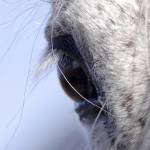Flehmen: The Horse with the Upturned Lip

Flehmen is the term used to describe the behavior in which a horse extends its neck, raises its head, and inhales as it rolls its upper lip back, displaying its front teeth. Expressing this behavior is called flehming or flehmening.
Why do horses exhibit the flehmen response?
In an article published in Compendium Equine, Dr. Sharon Crowell-Davis explains that horses display the flehmen response to facilitate transfer of inhaled scent molecules (pheromones and possibly some other substances) into the vomeronasal organ (VNO), a specialized chemosensory structure found in many mammals.
What is the function of the vomeronasal organ?
Once known as Jacobson’s organ, the VNO has different physical forms and locations in various species of animals. In general, it is connected with the mouth, nasal passages, or both. When certain scents impact the VNO, signals are transmitted via the vomeronasal nerve to centers in the brain’s accessory olfactory bulbs. Depending on the scent detected, various physiologic and behavioral reactions may then be triggered.
Do all horses show this behavior?
Stallions show the flehmen response most frequently, often after sniffing a mare’s urine or simply when they are in the presence of a mare in estrus. Visual cues may be important in the stallion’s response, as stallions whose vision was blocked showed a lower frequency of flehmen than stallions that could watch mares urinating. Crowell-Davis says, “It appears that flehmen facilitates chemosensory priming of stallions for reproductive behavior, rather than being an immediate component of sexual behavior.”
What about mares and geldings?
Mares commonly show a peak in flehmen response during the first few hours after giving birth.
Smelling the newborn foal and the amniotic fluids associated with birth often produce the reaction. Geldings show the behavior less frequently than other mature horses, although any horse is likely to flehmen when it encounters a novel scent such as a new dietary supplement or feed ingredient. Odors like smoke or fresh paint may also cue flehmen. Sniffing another horse’s urine or feces, or even their own waste, is likely to invoke an upturned lip, and horses produce the reaction from time to time when there is no stimulus that their owners can detect.
Do foals exhibit flehmen?
Foals of both sexes show the flehmen response. Young colts flehmen up to five times more frequently than fillies, and fillies flehmen more frequently than mature mares. Crowell-Davis says, “Evidence to date suggests that exposure to urine may be important for normal physical and sexual maturation in colts. Therefore, it is important, especially for orphaned colts that may be kept as stallions, to expose colts to urine during their early development, particularly during the first three months of life when the rate of showing flehmen is especially high among colts living in a natural herd environment.”
Is flehmen seen in other mammals?
Flehmen has been documented in dogs, cats, pigs, cattle, buffalo, tigers, lions, giraffes, goats, and llamas as well as in tapirs, which are not-so-distant cousins of the horse. In some animals like dogs, flehmen is shown after licking a surface or object rather than inhaling an odor.
What about humans?
When a person is exposed to unpleasant sights or smells, he or she tend to roll the upper lip back in disgust (the linguistic roots of this word signify something you wouldn’t want to eat), but because this action is not usually accompanied by inhalation, it may not have the same origin as the flehmen response in horses. Interestingly, the VNO is present in human embryos. However, although identifiable vestiges are found in some adults, this organ does not appear to perform a significant function in mature humans.
Is flehmen ever a cause for concern?
Actions similar to flehmen (raised head, extended neck, curled lip, or yawning motions) are sometimes seen as colic pain is developing, or when a horse is experiencing low-level gastrointestinal discomfort. There is some indication that the same actions may be shown when a horse is trying to relieve throat irritation; has feed or other objects caught in its mouth or teeth; is feeling stress or anxiety; or is relaxing after a period of stress or work. With all these possibilities, it’s hard to be sure why a horse is showing a certain behavior. To be safe, owners should keep an eye on a horse that begins to show ANY signs that are out of that horse’s normal pattern, and should ask a veterinarian to examine the horse if there is a question about its health status.








